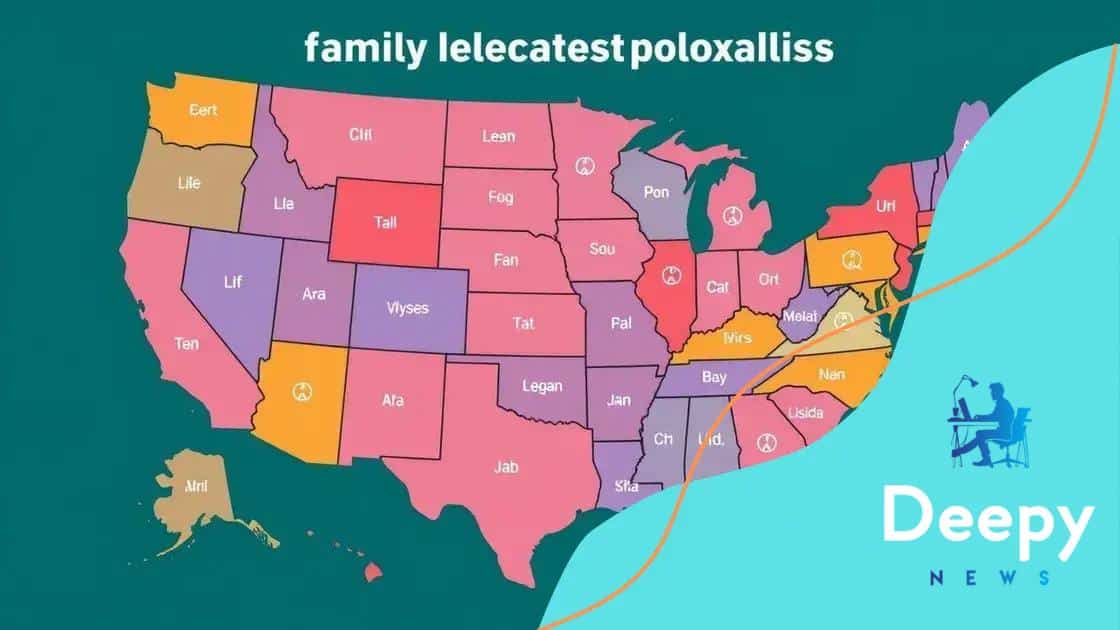Updates on paid family leave in the U.S. for 2023

Updates on paid family leave in the U.S. show states are increasingly offering support for families through more comprehensive policies, enhancing employee benefits and workplace flexibility.
Updates on paid family leave in the U.S. are crucial for families navigating work-life balance. As policies evolve, understanding the latest changes can empower you to make informed decisions. What’s changing, and how does it affect your situation? Let’s find out.
Current status of paid family leave legislation
The current status of paid family leave legislation is essential for understanding how it affects families today. Many states have taken significant steps to implement laws aimed at supporting working families during crucial times.
Recent Legislation Updates
In recent years, several states have introduced new paid family leave policies, providing support for caregivers during family emergencies. As of now, states like California and New York have established comprehensive leave programs that allow workers to take time off without sacrificing their income.
Key Features of Effective Paid Family Leave
- Duration of leave can range from several weeks to several months.
- Workers are generally compensated at a percentage of their average weekly wages.
- Eligibility often includes various family circumstances, such as the birth of a child or caring for a sick family member.
Each state’s program varies widely, making it crucial for employees to be aware of the specific benefits and qualifications applicable to them. Government data shows that states with paid leave tend to have better health outcomes for both parents and children. Moreover, businesses in these states report increased employee satisfaction and lower turnover rates.
Despite progress, challenges remain. There is ongoing debate about whether to expand paid family leave on a national level, with advocates pushing for universal policies to ensure all families have access. The lack of federal standards means that millions of workers may still lack the necessary protections.
As legislation continues to change, workers should stay updated on new developments. Understanding your rights and options can empower you to seek the support you need when family matters arise.
Key benefits for families and businesses
Understanding the key benefits for families and businesses regarding paid family leave is vital in today’s work environment. These benefits extend beyond just support for employees; they impact overall workplace culture and productivity.
Benefits for Families
Paid family leave allows parents to bond with a new child or care for a sick family member without the stress of lost income. Families can focus on important life events together. This time together promotes health and well-being, creating a stronger family unit.
- Improved mental health for parents, reducing stress during major life changes.
- Better outcomes for children, including improved health and development.
- Increased family stability, which can enhance relationships.
Furthermore, knowing that they are supported during tough times leads to higher job satisfaction for employees. This can translate into greater loyalty to their employer and increased productivity upon return.
Benefits for Businesses
Many companies overlook the advantages that paid family leave brings to their business environment. For example, businesses that offer paid family leave report higher employee retention rates. This reduces the costs associated with hiring and training new staff.
- Companies enjoy less absenteeism, as employees feel more valued.
- Attracting top talent becomes easier when competitive benefits are present.
- Fostering a positive workplace culture enhances overall morale.
By investing in paid family leave, companies can create an environment where employees feel respected and supported. Such an environment not only improves company performance but also enhances creativity and collaboration among team members.
As the landscape of family leave continues to evolve, recognizing these benefits becomes essential. Families and businesses alike can thrive when there is a focus on supporting personal and professional development.
State-by-state variations in family leave policies

The state-by-state variations in family leave policies highlight the differences in how families are supported across the U.S. Each state has its own laws, which can create confusion for employees and employers alike.
Overview of Family Leave Policies
Some states, like California and New York, offer robust paid family leave programs. These programs provide several weeks of paid leave for new parents or those caring for sick family members. Conversely, many states have no formal family leave policies.
Key Variations by State
- California: Offers up to 8 weeks of paid family leave at about 60–70% of wages.
- New York: Provides up to 12 weeks of paid leave at 67% of average weekly earnings.
- Oregon: Recently expanded its paid family leave to 12 weeks, with benefits similar to California’s.
Other states, like Texas and Florida, currently do not offer any paid family leave, relying instead on federal laws, which provide unpaid leave. This can limit options for families who need immediate financial support during challenging times.
Understanding these differences is crucial for employees planning family leave. Families in states with paid options can have a smoother transition during significant life events. They can focus on family without the added stress of financial strain, ultimately benefiting their overall well-being.
As the conversation about family leave continues, many advocates are pushing for unifying standards to ensure all families can access necessary support. This is part of a growing movement to make sure that everyone, regardless of where they live, can count on some form of family leave when they need it most.
Challenges faced by employees and employers
The challenges faced by employees and employers in navigating paid family leave policies can be significant. While these policies aim to support families, they also introduce complexities that affect all parties involved.
Common Issues for Employees
Employees often find themselves confused about their rights and the specific benefits available to them. Many may not fully understand the application process or the amount of pay they can expect during their leave. This lack of clarity can lead to uncertainty and stress during critical life events.
- Limited knowledge of policies can result in missed opportunities for paid leave.
- Fear of job loss or negative repercussions can prevent employees from taking necessary leave.
- Workers may struggle to balance personal needs with workplace demands, causing anxiety.
Moreover, employees working in states with no or limited paid family leave face the added burden of financial strain when needing time off.
Challenges for Employers
Employers also encounter hurdles with paid family leave policies. They must stay updated on various state and federal regulations, which can change frequently. This requires investment in training and resources to ensure proper compliance. Employers may also worry about how leave policies impact productivity and team dynamics.
- Managing workloads during employee absences can create disruptions.
- Cost considerations for providing paid leave can be challenging for smaller businesses.
- Finding a balance between supporting employee needs and maintaining business operations can be difficult.
Another critical aspect is the potential for disparities in how different employees are treated. Employers must ensure fairness and equity in granting leave, which can be complicated in diverse workplaces. Building a culture that respects and supports employees’ needs is invaluable but requires ongoing commitment and communication.
As discussions around paid family leave evolve, it is essential for both employees and employers to advocate for clear policies. Transparent communication and shared understanding can help navigate these challenges, creating a more supportive environment for everyone involved.
What to anticipate in future family leave developments
Understanding what to anticipate in future family leave developments is crucial for both employees and employers. As discussions around family leave continue, it is likely that new policies will emerge aimed at improving support for families.
Potential Legislative Changes
There is a strong movement towards implementing national paid family leave policies. Advocates argue that a federal standard would provide consistent benefits for all workers, regardless of where they live. This could lead to more uniform regulations across the country, simplifying the process for families who need support during crucial life events.
Trends in the Workplace
Employers are increasingly recognizing the need to prioritize employee well-being. Many businesses are expanding their leave policies beyond what is legally required. This means more companies may offer flexible leave options, allowing employees to take time when they need it most, without the fear of losing income.
- Expanded eligibility for family leave, accommodating various family structures and needs.
- Increased awareness of mental health during family transitions.
- Enhanced workplace culture focusing on employee support and satisfaction.
Furthermore, as remote work becomes more prevalent, family leave policies may adapt to consider work-life balance in new ways. Companies might explore innovative solutions that allow employees to blend work responsibilities with family needs more seamlessly.
The Role of Technology
Technology will likely play a significant role in the evolution of family leave policies. Online platforms can help streamline the application process, making it easier for employees to access their benefits. This could also enhance communication between employers and employees about available leave options.
As workplace dynamics shift, employees should stay informed about any changes in family leave policies. Understanding these developments will help families plan better and ensure they can take the leave they need during important times.
FAQ – Frequently Asked Questions about Paid Family Leave
What is paid family leave?
Paid family leave is a policy that allows employees to take time off work to care for family members or bond with a new child while receiving a portion of their pay.
How does paid family leave benefit employees?
Employees benefit from paid family leave by having the financial support needed to take time off without the stress of lost income during critical family events.
What challenges do employers face regarding family leave?
Employers may face challenges like keeping up with changing regulations, managing workloads during employee absences, and ensuring they treat all employees fairly.
What can we expect in the future regarding family leave policies?
In the future, we can expect more comprehensive national policies that provide clearer guidelines and increased support for working families.






